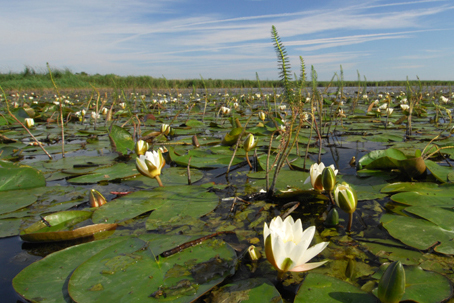Water quality
Restoring clear water and life to the lakes and rivers of the Broads is one of our fundamental aims.
 Years of research and experimental management have revealed what the waterways were like around a century ago with clear water and plenty of birds and aquatic plants.
Years of research and experimental management have revealed what the waterways were like around a century ago with clear water and plenty of birds and aquatic plants.
Since then increased numbers of people, boats and intensive agriculture in the Broads area has resulted in high levels of harmful nutrients and contaminants in the water. Furthermore, sewage outfalls are also affecting water quality, caused by the discharge of wastewater into the rivers.
Clear water now only occurs in about five of the 63 broads so, a Water Quality Partnership was established with the Environment Agency, Natural England, and other scientists and wetland experts to seek practical ways of repairing years of ecological decline. The Water Quality Partnership was subsumed by the Broadland Catchment Partnership in 2013 which consists of a partnership between the Broads Authority and Norfolk Rivers Trust.
The Broadland Rivers Catchment Plan provides actions for land management and wastewater management to improve water quality and deliver multiple benefits including for flood risk reduction, wildlife habitat, and recreational access.
Techniques used to improve water quality
Cloudy water is often caused by excessive nutrients like phosphorus, which fuel algal blooms. These algae block sunlight, choking aquatic plants and disrupting the natural balance.
There are a number of techniques which we, and other partner organisations, have used over the years to tackle the problem of water quality.
- Phosphorus control - removing the harmful nutrient phosphorous from treated sewage
- Suction dredging - removing nutrient-rich mud from the bottom of rivers and lakes like Barton Broad, the largest broad to have been dredged in this way
- Biomanipulation by removing the fish which eat water fleas, giving water fleas a chance to graze algae and clear the water
- Reduction of nutrients from agricultural sources through environmentally sensitive farming practices
- Educating boat users about environmentally friendly boating.
You can read in more detail about how we deliver the programme in the Lake Restoration Strategy which sets out the direction for the restoration of the Broads. The accompanying Lake Restoration Strategy Action Plan outlines priority actions and details future projects to be delivered over the course of the five year programme.
How you can help
With the help of both visitors and the people who live and work in the Broads we can improve water quality in our rivers and lakes.
Our environmentally friendly boating page gives more details about how you can help reduce the impact of your boating enjoyment on the Broads, including advice on reducing the effects of anti-fouling paint.
Our page on flea treatments and their impacts on water quality gives information on how harmful insectides found in pet treatments can severely affect aquatic insects and the wider food chain. There are simple practical changes that pet owners can make to drastically reduce their impact and these are outlined on the page.
The Environment Agency is asking householders with septic tanks and package treatment plants to help reduce the amount of the nutrient phosphate entering the waterways. You can find out more in the Environment Agency's septic tanks leaflet.

